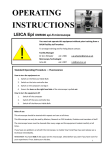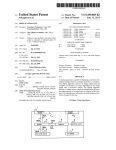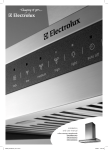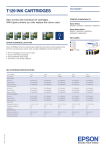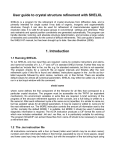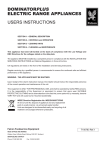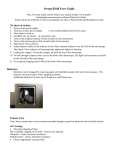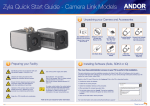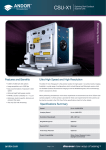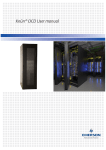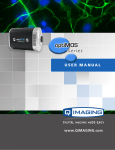Download DOWNLOAD NOW ALC-601 Laser Combiner The Andor Laser
Transcript
ALC-601 1024 x 1024 sensor, 26 fps Large Field of View EMCCD Ultimate Speed and Sensitivity Compact, flexible and robust. 6 line laser combiner Enhanced Laser Illumination Flexible configuration- up to 6 lines Supports multiple devices covering a broad range of applications High stability and robust design delivers optimal performance Features and Benefits • Next generation laser combiner Enhanced power delivery and stability at single mode fibre outputs • Borealis compatible Use multi-mode fibres with homogenizer for high intensity imaging • Multi-port fibre switch Supports complex microscopy systems • Direct laser TTL control For user-defined precision control • Linearised power output Corrects for AOTF non-linearity • Power down lasers Switch off unused lasers to extend lifetime • Power threshold protection Do not exceed power limit for delicate fibres • Class IIIB compliant version Support for up to 500mW • Class IV (> 500mW) version For super-resolution and related applications • Highly flexible and configurable platform System may be built to your specific requirements • Customer Special Request (CSR) system Specialised and experimental configurations are available using our CSR system The multi-line laser source delivering flexibility for demanding application needs The Andor Laser Combiner (ALC) is now in its 3rd generation, delivering a highly configurable laser delivery package to meet a wide variety of imaging application needs. Our long standing expertise in laser combiners means that you can be certain of owning a robust device with optimum performance both optically and mechanically, and which delivers a highly stable output. Laser safety is paramount in the design of the ALC-601 which is primarily supplied as a Class IIIb CDRH compliant device (up to 500mW) and includes full interlock connectivity. Offering up to 6 laser lines from 405nm up to 660nm, across a broad range of power options, you can configure the ALC-601 according to your budget and application needs. Laser line selection and power control are managed though an accousto-optical tuneable filter (AOTF), resulting in laser switching and incremental power control in the microsecond range. Enhance the ALC-601, with a multi-port unit (MPU) to provide high speed switching between two or three outputs to support multi-mode imaging. For example use a three port MPU for multi-point confocal TIRF illuminator and active illumination for photo-bleaching, photo-switching or uncaging. Included with the ALC-601 is the Precision Control Unit (PCU) which provides 8 TTL input and 8 TTL output channels as well as AOTF control. This provides the functionality, with the appropriate software, to send and receive trigger commands to peripheral devices as part of an imaging experiment. Additional TTL connectivity is provided for direct laser modulation, if desired, and an ultra-fast driver module (UFDM) can also be added for applications such as FLIM (Fluorescence lifetime microscopy) and ALEX (Kapanidis et al., 2005). Key Specifications Max number of lasers 6 Wavelength range (nm) 405-660 TTL control interface 8 TTL input and 8 TTL output channels Integral AOTF clean emission , <2 µs wavelength switching Active Laser blanking 2 µs on/off times Linearized power control Linearity <5% FSD, Resolution 0.1% Optional multi-port unit 2,3 ports: switching time <2 ms all ports Optional ultra-fast driver up to 150 MHz TTL modulation High power option >500 mW Class IV 1 ALC-601 Compact, flexible and robust. 6 line laser combiner 1024 x 1024 sensor, 26 fps Large Field of View EMCCD Ultimate Speed and Sensitivity Laser modulation options ALC-601 uses an integral AOTF for control of all laser lines and this provides significant benefits: • First, it provides high speed and precision across the full intensity range (100-0.1%; 0.1% steps) making the ALC-601 an ideal product for complex imaging needs, like localization microscopy and minimal exposure microscopy (O’Connell et al., 2009 http://www.ncbi.nlm.nih.gov/pmc/articles/PMC2762104/ ) • Second, the AOTF provides fast gating for Active Laser Blanking, minimizing specimen exposure and readout artefacts when combined with ultra-sensitive EMCCD and rolling shutter sCMOS cameras. • Third, ALC-601 delivers extremely rapid wavelength switching (~2 µs) and simultaneous multi-band excitation. • Finally, for experiments requiring ultra-fast switching, like alternating laser excitation ALEX (Kapanidis et al. 2005 http://www.conoptics.com/wp-content/ uploads/2013/09/Alternating-Laser_Excitation_of_Single_Molecules.pdf) the AOTF can be left open on multiple simultaneous channels and the ALC Ultrafast driver board is available for direct modulation up to the laser maximum (150 MHz for some diode lasers). Left: Time lapse images showing mitosis in HeLa cells (time in hr:min) This experiment illustrates how minimal exposure combined with laser spinning disk microscopy preserves live cell health and function.. Image Courtesy of Alexey Khodjakov, Division of Translational Medicine, Wadsworth Center, New York State Department of Health, Albany, NY. ALC-601 laser options The laser wavelengths and powers supported are outlined in the table below. An ultra-fast driver module (UFDM) is available for applications requiring 10’s MHz switching rates. Wavelength (nm) Power Rating (mW) 405*** 100 445*** 40, 50 488*** 50, 60 488** 50, 100, 150+, 200+ 491.5* 50, 100 515* 50, 100, 150+ 532** 50, 100, 150+, 200+, 300+ 561.2* 50, 100, 150, 200, 500+ 593.6* 50, 100 640*** 100 659.6* 400+ Wavelength variation (nm) depends on laser type: * ±0.3, ** ±2, *** ±5 + denotes on special request. Above: Maximum intensity projection of z-series from Zebrafish retina highlighting nuclei (blue), green and red sensitive cones (green) and 2 different types of bipolar cells (red & yellow). Courtesy of Tim McGinn, Stenkamp Lab, University of Idaho, USA. 2 ALC-601 1024 x 1024 sensor, 26 fps Large Field of View EMCCD Ultimate Speed and Sensitivity Compact, flexible and robust. 6 line laser combiner Specifications•1 Optical Specifications Specification Single Fibre Output MPU Dual or Triple Fibre Outputs Laser Configurations Up to 6 Diode Lasers 5 Diode + 1DPSS/OPSS Lasers 4 Diode + 2DPSS/OPSS Lasers 3 Diode + 3DPSS/OPSS Lasers 1 Diode Laser (@ 640nm) + 4 DPSS/OPSS Lasers Laser Output Power (Fibre Coupled) 500mW Maximum for Class IIIB Class IV (>500mW emission) version available under CSR Fibre coupled Power Stability ≤2% per oC RMS Noise (10Hz – 10MHz) <1% Output Polarisation Extinction Ratio (Typ.) >100:1 Fibre Optic Type Single mode, polarisation maintaining, stainless steel armoured cabling or multi-mode used with Borealis illumination. Fibre Output Connector Selectable - FC/AFC, FC/APC, FC/PC Rise / Fall Time <2 µS Extinction Ratio 50 dB (fibre end: >60dB) Signal Lag <2 µS Digital Modulation •2 (Diode Lasers) Rise / Fall Time <20 ns Max. Freq. 150 MHz Digital Modulation (OPSS Lasers) Rise / Fall Time 18/2 µS Max. Freq. 50 kHz Active Blanking (Electronic Shuttering) MPU Switching Speed (optional) N/A <2 mS (Port A-B or B-C) <2 mS (Port A-C) MPU Max. Switching Freq. (Optional) N/A 100 Hz Electronic Specifications Specification Single Fibre Output MPU Dual or Triple Fibre Outputs Control Interface USB2.0 and 37 Pin D-sub connector (PCI I/O Card included) Digital Modulation Option (UFDM) 6 x SMB Connectors (50Ω), TTL. Allows independent, asynchronous control FLIM Modulation Option (UFDM) 1 x BNC (50Ω) – Distributes the modulation signal to up to 4 diode lasers simultaneously, TTL. Software selection of individual laser control mode Active Blanking 3 x BNC (50Ω) Inputs with OR logic (Via PCU) AOTF controlled, shutters all output Digital Inputs 8 x BNC (50Ω), TTL (Via PCU) Digital Outputs 8 x BNC (50Ω), TTL (Via PCU) Power Supply Requirements Power Consumption Mains: 100 – 240V a.c., 50 – 60Hz 350 W Max. + 15W (MPU Controller) Laser Standby Mode Independent Software control of each laser to greatly extend laser life ~ 90 seconds warm-up time after re-enable Laser Power Control AOTF controlled, Linearised output, 0 – 100%, 0.1% resolution Linearity ±5% Laser Output Control AOTF controlled, up to 6 lines with independent and asynchronous control Absolute maximum incident laser power = 5 W 3 ALC-601 1024 x 1024 sensor, 26 fps Large Field of View EMCCD Ultimate Speed and Sensitivity Compact, flexible and robust. 6 line laser combiner Mechanical Specifications Specification Single Fibre Output MPU Dual or Triple Fibre Outputs ALC-601 Dimensions (WxDxH) 483mm x 530mm x 184mm 483mm x 593mm x 210mm 4U 19” Sub-rack BS EN 60297 (Aluminium Construction) Andor Revolution XD 19” Rack-mount Cabinet (Optional) Rubberised feet allow for bench-top mounting ALC-601 Enclosure and Mounting Format ALC-601 Weight 38Kg Max. (6 Lasers) 42kg Max. (6 Lasers) PCU Dimensions (WxDxH) 483mm x 316mm x 133mm PCU Enclosure and Mounting Format 3U 19” Sub-rack BS EN 60297 (Aluminium Construction) Andor Revolution XD 19” Rack-mount Cabinet (Optional) Rubberised feet allow for bench-top mounting PCU Weight 8kg MPU Controller Dimensions (WxDxH) 483mm x 324mm x 95mm MPU Controller Enclosure and Mounting Format 2U 19” Sub-rack BS EN 60297 (Aluminium Construction) Andor Revolution XD 19” Rack-mount Cabinet (Optional) Rubberised feet allow for bench-top mounting MPU Controller Weight 5kg General Specifications Specification Single Fibre Output MPU Dual or Triple Fibre Outputs Control Software Andor iQ MetaMorph Micro-Manager LabView Driver available on request Operating Temperature 23°C ± 5°C (Indoor use only) Operating Relative Humidity <70% (Non-condensing) Storage Temperature 0 - 50°C Operating Altitude Up to 2000 m Compliance Specifications Certification CE Compliant, CDRH Registered Classification Class IIIb (IEC 60825-1 and CDRH) Class IV (IEC 60825-1 and CDRH) available under special request RoHS Compliant Yes Laser Safety Features Key operated master switch, shrouded fibre connection, laser safety interlock kit inc. remote interlock connection Borealis: high throughput and uniform illumination with CSU-X and CSU-W Borealis enhanced CSU-X Find out more about Borealis at: www.andor.com/microscopy-systems/ revolution/borealis Andor EMCCD and scientific CMOS: the ultimate in detection Andor iXon EMCCD Andor sCMOS To find out more about Andor’s range of EMCCD and scientific CMOS detectors, please see: www.andor.com/scientific-cameras 4 ALC-601 1024 x 1024 sensor, 26 fps Large Field of View EMCCD Ultimate Speed and Sensitivity Compact, flexible and robust. 6 line laser combiner Product Drawings Dimensions in mm [inches] Standard ALC-601 ALC-601 with MPU Top panel Front panel (top) and rear panel (below) 5 ALC-601 Compact, flexible and robust. 6 line laser combiner 1024 x 1024 sensor, 26 fps Large Field of View EMCCD Ultimate Speed and Sensitivity PCU MPU Controller 6 ALC-601 Compact, flexible and robust. 6 line laser combiner 1024 x 1024 sensor, 26 fps Large Field of View EMCCD Ultimate Speed and Sensitivity Order Today Need more information? At Andor we are committed to finding the correct solution for you. With a dedicated team of technical advisors, we are able to offer you one-to-one guidance and technical support on all Andor products. For a full listing of our regional sales offices, please see: andor.com/contact Our regional headquarters are: Europe Japan Belfast, Northern Ireland Tokyo Phone +44 (28) 9023 7126 Phone +81 (3) 6732 8968 Fax +44 (28) 9031 0792 Fax +81 (3) 6732 8939 North AmericaChina Connecticut, USA Beijing Phone +1 (860) 290 9211 Phone +86 (10) 8271 9066 Fax +1 (860) 290 9566 Fax +86 (10) 8271 9055 Supplied Components 1 x ALC-601 (supplied with purchased lasers installed). ALC enclosures are 19” rack mount capable. An optional wheeled rack system is available. 1 x PCU-100 precision controller with TTL I/O and AOTF controller. 1 x Single or multi-mode optical fibre suitable for selected application (Borealis requires multi-mode). 1 x PCI-DAC card and D-37 cable for PC control interface. 1 x USB cable. Power cords for local mains supply. 1x User Manual Footnotes: Specifications are subject to change without notice 1. All specifications are typical. 2. Requires optional ultra-fast driver module (UFDM) 3. ALC-601 models are registered CDRH and IEC Class 3B or Class 4 according to laser selections. 4. Installation, service and upgrade should be performed by qualified personnel. 5. All local safety standards should be followed by users. 6. If your specific requirements are not covered in this document, please contact your sales channel. We will certainly consider special requests. Optional: Ultra-fast driver module (UDFM) for high speed switching integrated into ALC enclosure. MPU: multi-port head integrated with ALC; MPU controller. Additional (one or two) single mode optical fibres for selected MPU. Software Compatibility: • Andor iQ, Micro-Manager, MetaMorph, QuickPALM, Software Development kit (SDK) available on request Regulatory Compliance •EU EMC/ LV/ Machinery/ RoHS Directives •Laser safety compliant for IEC 60825-1 and CDRH 21 CFR 1040.10 (Class 4 under special request) Operating & Storage Conditions • Indoor use only • Operating Temperature: 18°C to 28°C ambient • Operating Relative Humidity: <70% (non-condensing) • Operating Altitude: Up to 2000m FM40523 EMS91062 OHS502497 • Storage Temperature: 0°C to 50°C ambient Power Requirements • Mains Power supply: 100-240 VAC, 50/60 Hz • Power consumption: 350 W Max. (+15W MPU Controller) ALC601SS 0615 R1 7








